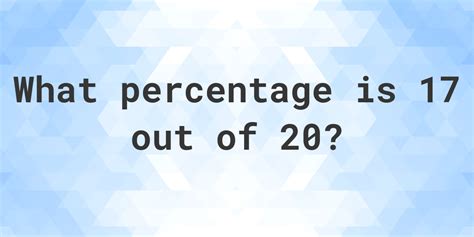What Is The Percentage Of 17 20
Kalali
Mar 26, 2025 · 4 min read

Table of Contents
What is the Percentage of 17 out of 20? A Comprehensive Guide
Calculating percentages is a fundamental skill with broad applications in various aspects of life, from academic studies and financial planning to everyday decision-making. Understanding how to determine the percentage one number represents of another is crucial for interpreting data, making comparisons, and solving practical problems. This article delves into the process of calculating the percentage of 17 out of 20, providing a detailed explanation, various methods, and practical examples to solidify your understanding.
Understanding Percentages
Before we dive into the calculation, let's clarify what a percentage represents. A percentage is a fraction or ratio expressed as a number out of 100. The symbol "%" represents "per cent," meaning "out of one hundred." For instance, 50% signifies 50 out of 100, which is equivalent to 1/2 or 0.5.
Calculating the Percentage of 17 out of 20: Three Methods
There are several ways to determine what percentage 17 represents of 20. We'll explore three common methods:
Method 1: Using the Fraction Method
This is perhaps the most straightforward approach. We can express the relationship between 17 and 20 as a fraction: 17/20. To convert this fraction into a percentage, we need to multiply it by 100%:
(17/20) * 100% = 85%
Therefore, 17 out of 20 is 85%.
Method 2: Using Decimal Conversion
This method involves converting the fraction into a decimal first, and then multiplying by 100%. Let's do it:
- Convert the fraction to a decimal: 17 divided by 20 = 0.85
- Multiply the decimal by 100%: 0.85 * 100% = 85%
Again, we arrive at the same answer: 85%.
Method 3: Using Proportions
This method utilizes the concept of proportions. We can set up a proportion to solve for the unknown percentage (x):
17/20 = x/100
To solve for x, we cross-multiply:
20x = 1700
Now, divide both sides by 20:
x = 1700 / 20 = 85
Therefore, x = 85%, confirming our previous results. This method is particularly useful when dealing with more complex percentage problems.
Practical Applications and Real-World Examples
Understanding percentage calculations is vital in numerous real-life situations. Here are a few examples showcasing the practical application of calculating the percentage of 17 out of 20:
-
Academic Performance: Imagine a student scores 17 out of 20 on a test. Their percentage score is 85%, indicating a strong performance.
-
Sales Targets: A salesperson aims to sell 20 products and successfully sells 17. Their sales achievement is 85%, showing they nearly reached their target.
-
Project Completion: A team completes 17 out of 20 tasks in a project. Their project completion rate is 85%, providing a clear measure of progress.
-
Survey Results: If 17 out of 20 respondents agree with a particular statement in a survey, the percentage agreement is 85%, giving insight into public opinion.
-
Financial Investments: If an investment of $20 yields a return of $17, the return on investment is 85%.
Expanding Your Understanding: More Complex Percentage Calculations
While the calculation of 17 out of 20 is relatively straightforward, understanding the underlying principles enables you to tackle more complex scenarios. For example:
-
Calculating Percentage Increase or Decrease: This involves determining the percentage change between two values. The formula is: [(New Value - Old Value) / Old Value] * 100%.
-
Finding the Original Value: If you know the percentage and the resulting value, you can work backward to find the original value.
-
Working with Percentages of Percentages: This involves calculating percentages of percentages, requiring a step-by-step approach.
-
Applying Percentages to Compound Interest: Calculating compound interest involves applying percentages repeatedly over time.
Mastering Percentage Calculations: Tips and Tricks
To become proficient in percentage calculations, consider these helpful tips:
-
Practice Regularly: Consistent practice is key to mastering any mathematical concept. Solve various percentage problems to build your skills and confidence.
-
Use Calculators Strategically: Calculators can aid in complex calculations, but it's crucial to understand the underlying principles before relying solely on a calculator.
-
Visualize the Problem: Representing the problem visually, such as with a pie chart or bar graph, can help in understanding the relationship between the numbers.
-
Check Your Work: Always double-check your calculations to ensure accuracy. Using different methods can help verify your answer.
Conclusion: The Power of Percentage Understanding
Understanding percentage calculations is a valuable skill with widespread applications. The ability to accurately calculate and interpret percentages empowers informed decision-making in various aspects of life, from personal finance to professional endeavors. Mastering this fundamental skill opens doors to more advanced mathematical concepts and enhances your ability to analyze data effectively. Remember, practice is key to becoming proficient, and with consistent effort, you can confidently tackle any percentage-related problem. The simple example of calculating the percentage of 17 out of 20 serves as a solid foundation for building your understanding and tackling more complex percentage calculations in the future.
Latest Posts
Latest Posts
-
Is The Knee Proximal To The Ankle
Mar 29, 2025
-
What Is 15 Percent Of 120
Mar 29, 2025
-
Cuanto Es 200 Grados Centigrados En Farenheit
Mar 29, 2025
-
What Is 17 Out Of 20
Mar 29, 2025
-
How Many Oz Are In 250 Ml
Mar 29, 2025
Related Post
Thank you for visiting our website which covers about What Is The Percentage Of 17 20 . We hope the information provided has been useful to you. Feel free to contact us if you have any questions or need further assistance. See you next time and don't miss to bookmark.
